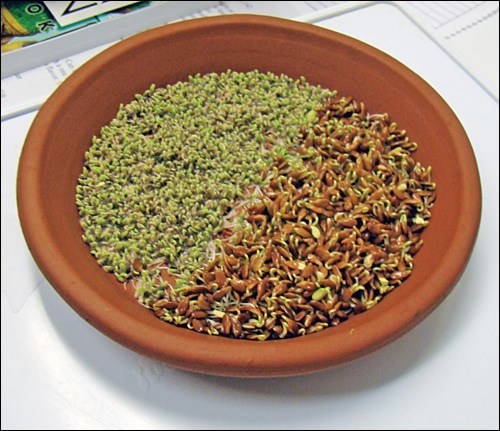One of the most dismal parts of winter can be the lack of local fresh produce in our kitchens. However, with a few seeds and some water; fresh, nutrient rich sprouts can be grown as local as in your own kitchen, year round.
Sprouts are tiny growing plants, germinated from seeds. The sprouting process triggers multiplication of proteins, transforms carbohydrates into simple sugars for energy and combines minerals with amino acids for greater assimilation into the human body. Sprouts are an excellent source of anti-oxidants. Some of the seeds recommended for sprouting include alfalfa, red clover, sunflower, almond, broccoli, buckwheat, chick pea, lentil, mung bean, mustard, radish, sesame, soybean and wheat.
Sprouting seeds is easy. Only a few supplies are needed: a small amount of good quality seeds, a large glass or clear plastic jar with a wide opening (such as a quart sized jar used for canning dill pickles) and a square of nylon mesh or screen along with a rubber band that will fit over the mouth of the jar.
Step one of the sprouting process is soaking seeds. Place seeds in the jar and cover the seeds with clean, potable water at room temperature. Soak smaller seeds like broccoli or radish for 6 hours and larger seeds like beans or peas for 12 hours. After this soaking or swelling stage, pour out water through the mesh and rinse seeds with fresh water.
After soaking, draining and rinsing seeds, place the jar in a dark place if possible. Wait for the seeds to germinate: this can take anywhere from one to twelve days, depending on the seed. While waiting for seeds to germinate, the seeds should be rinsed at least twice daily (morning and evening) and preferably three times/day. Always use clean water near room temperature for rinsing. Once seeds begin to produce leaves, place the container in a bright spot to allow green chlorophyll in the leaves to develop. Never place any sprouting seeds in direct sun. Sprouts are ready to eat as soon as leaves or roots are visible.
Sprouts that lose their hulls, i.e. sunflowers, need to be cleaned in a different manner than seeds without hulls. Once the sunflowers have sprouted, place them in a sink or a big bowl filled with water. Gently separate the hulls from the sprouts using your fingers. The hulls will rise or sink in the water and must be manually removed from the sprouts.
Store sprouts in the fridge for up to two weeks. Keep the sprouts in a sealed container and rinse with cool water every two days. One of the main concerns with sprouting seeds is contamination of the sprouts with a harmful bacteria such as salmonella. The key to avoiding this risk of infection is to purchase and sprout seeds that are sold for sprouting purposes and have been tested for pathogens. For extra insurance, one can add one tablespoon of vinegar or five drops of food grade hydrogen peroxide (35 per cent) or one teaspoon of hydrogen peroxide (three per cent) to two cups of water for soaking seeds. The best way to avoid disease is to purchase seeds from a reputable source such as: Mumm's Sprouting Seeds - located in Parkside (www.sprouting.com); Sprout Master - Elmvale, Ont, (www.sproutmaster.com); Eatmore Sprouts - Courtenay, B.C. (www.eatmoresprouts.com)
For more detailed information about sprouting seeds, I recommend the book The Wonders of Sprouting by Lucie Desjarlais: available from your favourite sprouting seed supplier.
Happy sprouting!
Bantle is a horticulturist living in Saskatoon.
- This column is provided courtesy of the Saskatchewan Perennial Society (www.saskperennial.ca; [email protected]). Check out our Bulletin Board or Calendar for upcoming garden information sessions (Nov. 26:My Garden Project - a showcase of horticulture endeavors around town from training young gardeners to a family building a park).




